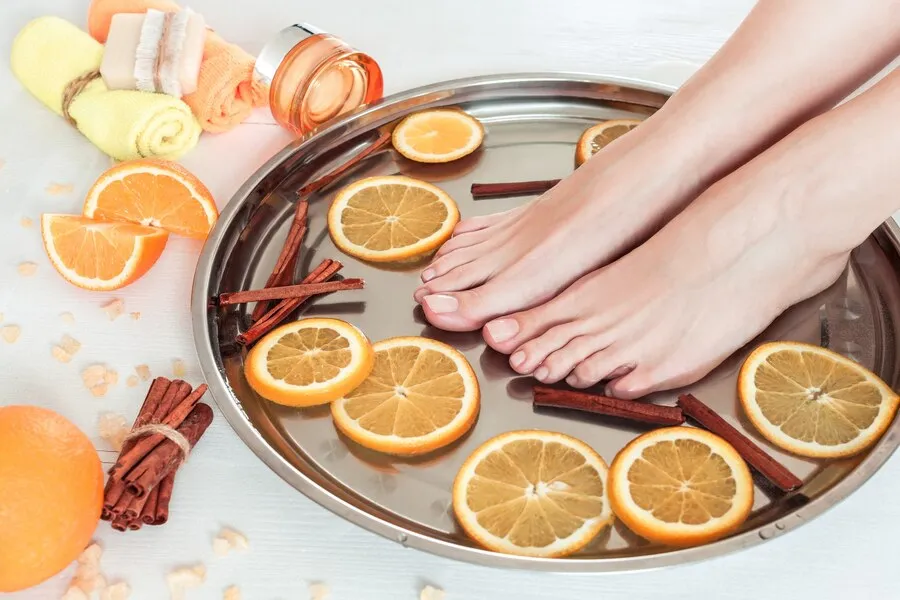Table of Contents
Our feet carry us through our daily lives, providing support and mobility. However, seasonal changes can significantly impact foot health. Each season brings unique challenges that require different care techniques. This article outlines essential seasonal foot care tips to keep your feet healthy and comfortable year-round.
Winter Foot Care
Winter can be harsh on your feet due to cold temperatures and dry air. Here are some crucial tips for maintaining foot health during this season:
- Moisturize Regularly: Cold weather can lead to dry, cracked skin. Use a rich moisturizer on your feet daily, focusing on the heels and soles, where the skin is thickest. Opt for creams containing ingredients like urea or shea butter for adequate hydration.
- Wear Appropriate Footwear: Insulated, waterproof boots are essential in winter. Choose shoes that allow for proper circulation and provide warmth. Avoid tight-fitting footwear that can restrict blood flow.
- Choose Socks Wisely: Opt for moisture-wicking socks made from wool or synthetic materials. These help keep your feet warm and dry, reducing the risk of fungal infections and frostbite.
- Foot Soaks and Exfoliation: Treat your feet to a warm foot soak to relieve dryness. Follow this with gentle exfoliation to remove dead skin, making it easier for moisturizers to penetrate.
Spring Foot Care
As the weather warms up, it’s essential to transition your foot care routine to accommodate the change in activity levels and conditions:
- Check for Dryness and Cracks: Inspect your feet for any signs of dryness or cracks that may have developed over winter. Treat these immediately to prevent more severe issues.
- Shoe Transition: As you swap winter boots for lighter footwear, ensure your shoes fit well and provide adequate support. Look for shoes that offer breathability, as the warmer weather can cause sweating. Consider exploring options for foot-shaped shoes, which feature a wider toe box. This design spreads your toes naturally, promoting better alignment and comfort.
- Pedicure Prep: Spring is the perfect time to pamper your feet with a pedicure. Remove dead skin, and consider applying a fresh coat of nail polish. Regularly trimming toenails helps prevent ingrown nails.
- Stay Active: With warmer temperatures, engaging in outdoor activities is an excellent time. Regular walking or hiking can improve circulation and strengthen the muscles in your feet.
Summer Foot Care
Summer often means increased exposure to heat and moisture, leading to various foot-related issues, including foot injury, athlete’s foot, or even foot ulcers. Proper foot care is essential to stay comfortable and healthy during the hot months. Here’s how to take care of your feet during summer:
Hydrate and Moisturize: The summer heat can lead to dehydration and dry skin, which may exacerbate corns, callus, and even foot pain. Continue to moisturizingur feet daily, paying particular attention to the bottom of your feet and avoiding putting lotion between your toes to prevent fungal growth. Remember, good foot care involves keeping feet clean and dry to prevent skin cracking and ulcer formation.
Choose Breathable Footwear: Open-toed sandals, athletic shoes, and regular shoes made of breathable materials are ideal for summer. This allows your feet and toes to stay cool, which helps reduce tingling and maintain healthy skin. When choosing new shoes, ensure they fit comfortably and do not cause blisters or sore areas. People with diabetes should be cautious about foot hygiene and nerve damage when selecting shoes and socks.
Practice Sun Protection: Just as you protect your skin from UV rays, remember to protect your feet by applying sunscreen to the shape of your feet, especially when wearing sandals. Sun damage can worsen diabetes foot care complications and affect foot health for people with diabetes.
Combat Fungal Infections: Summer’s warm, moist environment fosters athlete’s foot and other foot problems. Do not walk barefoot in public areas like pools or changing rooms to avoid these issues. Instead, keep your feet clean and use antifungal powder when necessary. Clean and dry your feet and legs thoroughly after swimming or sweating, which helps maintain proper foot hygiene and reduces the risk of developing more severe foot problems.
Fall Foot Care
As temperatures drop, it’s vital to adapt your foot care routine for the fall to maintain healthy feet and avoid complications like corn, callus, or ingrown toenails. Here are some tips to help you take care of your feet during the transition:
Warm Up Your Feet: Switching to warmer footwear like sneakers or therapeutic shoes is essential for keeping your feet and toes comfortable. Opt for shoes that fit, providing room to accommodate thicker socks without causing pressure on the ball of the foot, which can lead to blisters, ulcers, or other foot injuries. Ensure you see a podiatrist if you notice discomfort or foot pain due to improper shoe fit, as these can lead to neuropathy or worsen poor circulation.
Prepare for Moisture: With fall often comes rain, and keeping your feet clean and dry becomes challenging. Waterproof your new shoes to protect your feet and legs from dampness, which can lead to fungal issues like plantar warts or athlete’s foot. People with diabetes should be cautious, as poor circulation and diabetes cause heightened risks of foot ulcers. Remember to ask your doctor or consult a health care provider if you develop any symptoms.
Inspect and Treat for Fungal Infections: Keeping your feet clean is vital to avoid problems like nerve damage or plantar issues. Examine your feet regularly for any signs of fungal infections, blisters, or sore spots. See your doctor promptly for any foot problems you notice, as early detection is critical. A health professional may recommend using a nail file or emery board to keep toenails straight across, helping prevent ingrown toenails.
Exfoliate and Moisturize: The skin on your feet can thicken during cooler months, so using a pumice stone or foot file will help. Regular exfoliation prevents corns and calluses while promoting foot health. After exfoliating, apply a moisturizer to keep your feet healthy—but don’t forget that you shouldn’t put moisturizer between your toes as it might increase fungal risks.
Embrace Warmth and Comfort: Keeping warm is essential to maintain foot health as temperatures drop. Consider using foot warmers or heated blankets when relaxing at home. Move your ankles around and wiggle your toes to keep circulation flowing. For people with diabetes, these practices help prevent poor circulation and numbness in the feet and legs, promoting overall comfort.
General Foot Care Tips for All Seasons
Regardless of the season, maintaining foot health is crucial. Here are some general tips to follow throughout the year:
- Regular Check-Ups: Schedule regular foot check-ups with a podiatrist, especially if you have diabetes or other conditions that affect foot health. Routine examinations can help detect potential issues early, allowing for timely interventions to prevent complications.
- Stay Active: Engage in regular exercise to improve circulation and strengthen the muscles in your feet. Activities like walking, jogging, or swimming keep your feet fit and contribute to overall cardiovascular health. Incorporating foot-specific exercises can enhance flexibility and reduce the risk of injuries.
- Choose the Right Footwear: Always wear shoes that provide proper support and fit well. Footwear should accommodate your foot shape and provide adequate cushioning to prevent discomfort. Avoid high heels and shoes that lack proper arch support, leading to various foot problems over for shoes that allow your feet to move naturally while offering protection from environmental elements.
- Introduce Toe Separators: To improve foot alignment and relieve pressure, consider using toe separators. These devices help maintain proper spacing between your toes, which can be particularly beneficial for those who experience discomfort or conditions like bunions or hammertoes. With various options readily available, incorporating toe separators into your routine can enhance overall foot comfort and health.
- Maintain Hygiene: Wash your feet daily to maintain excellent foot hygiene. Be sure to clean between your toes thoroughly, as this area is prone to moisture buildup, which can lead to fungal infections. After washing, dry your feet thoroughly, particularly between the toes, to help prevent any potential issues.
- Be Mindful of Foot Pain: Don’t ignore persistent foot pain. Early intervention is critical to preventing more severe issues down the line. If you experience discomfort, consider consulting a healthcare professional to determine the underlying cause and receive appropriate treatment. Prompt attention can often make a significant difference in your foot health journey.
Also Read: How long does it take for a lawyer to get your disability?
Final Thoughts
Taking care of your feet throughout the changing seasons is essential for overall health and well-being. Following these seasonal foot care tips, you can keep your feet comfortable, healthy, and ready for whatever life brings.




